
Building low- or zero-carbon homes and buildings is the next step for zero-energy homes. To get on the path to zero carbon, reducing the embodied carbon in homes is an important step. Insulation materials can be a significant source of embodied carbon so builders need to choose those materials carefully. One way of comparing the global warming effects of different building materials, including insulation, is to compare their global warming potential (GWP).
The global warming potential
GWP allows comparisons of the global warming impact of different gases. It is a measure of how much energy the emissions of one ton of a gas will contribute to climate change over 100 years compared to the emissions of one ton of carbon dioxide (CO2). The higher the GWP, the more that a gas warms the Earth compared to CO2 over that time period. In other words, GWP provides a scale for telling how bad the emissions of a given gas are for the planet. (CO2 from burning fossil fuels is the standard on the scale, with a GWP of 1.) Methane has a GWP of 28—twenty-eight times the global warming potential of carbon dioxide per kilogram released. It makes little sense to reduce operational energy by using materials that add significant amounts of carbon to the atmosphere through their production. In the most extreme cases, it’s one step forward and two steps back. Builders and designers must begin to migrate to low GWP materials.
GWPs of different types of insulation vary widely
Different insulating materials have a wide range of GWP. Many closed-cell spray foams and rigid foam products have high GWPs. Cellulose, sheep’s wool, and straw have a low GWP and sometimes may actually store (sequester) carbon for many years.
Here is an overview of the climate impact of common insulation types and available low and very low GWP alternatives.
Rigid foam insulation
Two of the most common foam insulating materials are made with hydrofluorocarbon (HFC) blowing agents that are very potent greenhouse gases. Extruded polystyrene (XPS), used in Dow Styrofoam (“blueboard”) and Owens Corning Foamular (“pinkboard”) have R-5 per inch and are made with HFC-134a, which has a GWP of 1,430. On the other hand, expanded polystyrene (EPS) board (R3.9/inch) and polyisocyanurate foam board (R6/inch) are blown with pentane, which has a GWP of 7.
Conventional spray foam insulation
Blowing agents are an essential component of spray foam products. They are the gases used to expand the cells of plastic foam to increase its insulating capacity. Over time, blowing agents migrate out of the cells and end up in the atmosphere. So if you use a foam insulation product with a high GWP, it will amplify climate change. The energy saved from increased insulation will eventually offset this, but it could take up to a decade or longer to break even in terms of global warming. By using foam insulation products with higher GWPs, you may save costs but add greenhouse gases.
The blowing agents in many spray foams have a GWP in the thousands and are considerably higher than methane (GWP of 28). The average GWP of the most commonly used HFC blowing agents is over 3400. On average, each kilogram of these agents has as much global warming potential as 3400 kg of carbon dioxide.
The GWP of various gases used for foam insulation compared to CO2.
The first generation of CFC blowing agents had a GWP close to 5,000. Today’s third generation blowing agents, HFC-245fa and HFC365mfc, have a GWP of 700 to 1000. While significantly better than the original blowing agents, they are still significant contributors to global warming. Fortunately, low GWP spray foams are now available.
Low GWP spray foam insulation
Solstice and Opteon are two new low-GWP blowing agents now available with a GWP of less than 5. These 4th generation chemicals are hydrofluoroolefins (HFOs). One energy consultant compared the environmental “payback” time, costs, and carbon savings of Insulthane Extreme from Elastochem, which uses Solstice, with a standard blowing agent from BASF.
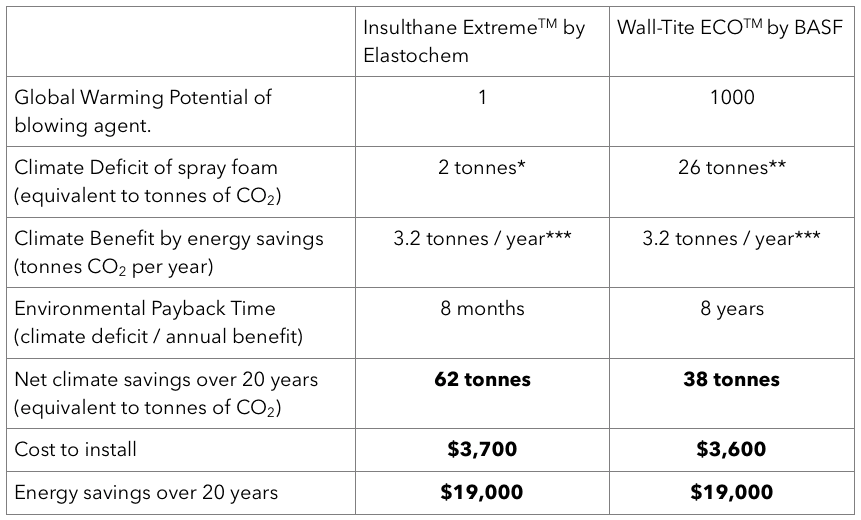
NOTES: Figures are approximate. Based on insulating the foundation and floor of a small basement in Halifax, Nova Scotia, Canada to R-28 all around the interior. *Estimated based on GWP and percentage of blowing agent. **Estimated based on data in the eco-efficiency report for the product. ***Energy savings of 6440 kWh / year, estimated using HOT2000 energy modelling software from Natural Resources Canada, at Nova Scotia electricity greenhouse gas emission intensity of 500g CO2 / kWh. The units used here are metric tonnes. One metric tonne is equal to approximately 1.1 U.S. ton.
Clearly, the low-GWP blowing agent Solstice, used in a variety of available products, is the winner for the environment. But what about the cost of construction? Solstice blown foam often costs more, but may have a higher R-value, so less foam is needed. The total price may be similar, while the low GWP product has a very significant environmental advantage. If you are considering spray foams for insulation, be sure to ask for spray foam with low GWP, such as ones that use Solstice or Opteon. Or consider the pros and cons of foams using water as a blowing agent.
Water blown spray foams
Water blown technology was first developed for use with open-cell foams, but is now available for closed-cell foams as well. Water in the mixture reacts during the application process to release CO2 and heat. The combination of CO2 and water vapor expand and create the three dimensional structure of the insulation. Because water reacts and creates CO2, the GWP of the blowing agent is only 1.
Icynene ProSeal Eco is a 100% water-blown medium-density closed-cell foam with a GWP of 1 and an insulating value of R4.9/inch. This product is now used in a variety of spray foams on the market under a variety of brand names.
A study by the Spray Polyurethane Foam Alliance indicates that in many U.S. climates, water-blown spray foams have a carbon payback period (greenhouse gas produced versus greenhouse gas avoided) of less than a year, whereas foams using 2nd and 3rd generation HFC blowing agents typically take at least two to three times longer to pay back. However, according to Honeywell, maker of Solstice, even though both water-blown foams and Solstice have a GWP of 1, and even though water based foam is less expensive per drum, there are some disadvantages of water-blown systems compared to HFOs that should be considered. They maintain that water-blown foams have “25% lower thermal insulation performance, a 25% greater volume change in dimensional stability due to the diffusion of the CO2 gas, a 13% higher foam density so more polymer is required to achieve equivalent foam thickness, and a 25% higher applied cost.” These are claims to be checked out with suppliers of water-blown products.
What about MDI in spray foam?
Even the very low-GWP spray foam products, whether Solstice, Opteon, or the water- based products, may not be sustainable because a key component of urethane is Methylene Diphenyl Diisocyanate (MDI) or related chemicals, which off-gas during the application process. They have been linked to health concerns including asthma and lung disease. Yet the U.S. Environmental Protection Agency has not regulated MDI and installers need to take the usual precautions. Little is known about their health effects for residents. For those concerned about MDI, please ask for a material safety data sheet (MSDS) on any product that you are considering using to verify the presence of absence of MDI in the foam product—including those that are bio based.
“Bio-based” spray foams
There are now some spray foam products that contain a small amount of bio-based materials, either soy or castor oil. They have a similar R-value and a GWP of 1. However, it would be more accurate to call these “bio containing” foams as they usually contain about 15% of the bio-based material. For example, one soy-based product, BioBased, uses Icynene and is only 15% soy and 85% polyurethane. Demilec’s HeatLokSoy product “contains more than 20% recycled plastic materials and soy” and Icynene makes a castor oil product with a “renewable content greater than or equal to 7%.” Due to the large number of spray foam products and the wide variety of chemical components involved, it’s best to thoroughly research the topic before purchasing.
Loose-fill and batt insulation
Loose-fill and batt insulation contain no petrochemicals and promise to have lower GWP. Common fiberglass has the lowest GWP of traditional insulation materials, but still has a significant GWP and presents well known health hazards to handlers and installers.
So what is the CO2 impact of both common and alternative non-foam based insulations compared to some foam products? Here is a chart of the carbon impacts of insulation that includes many of these products from a “Builders for Climate Action” 2019 white paper.
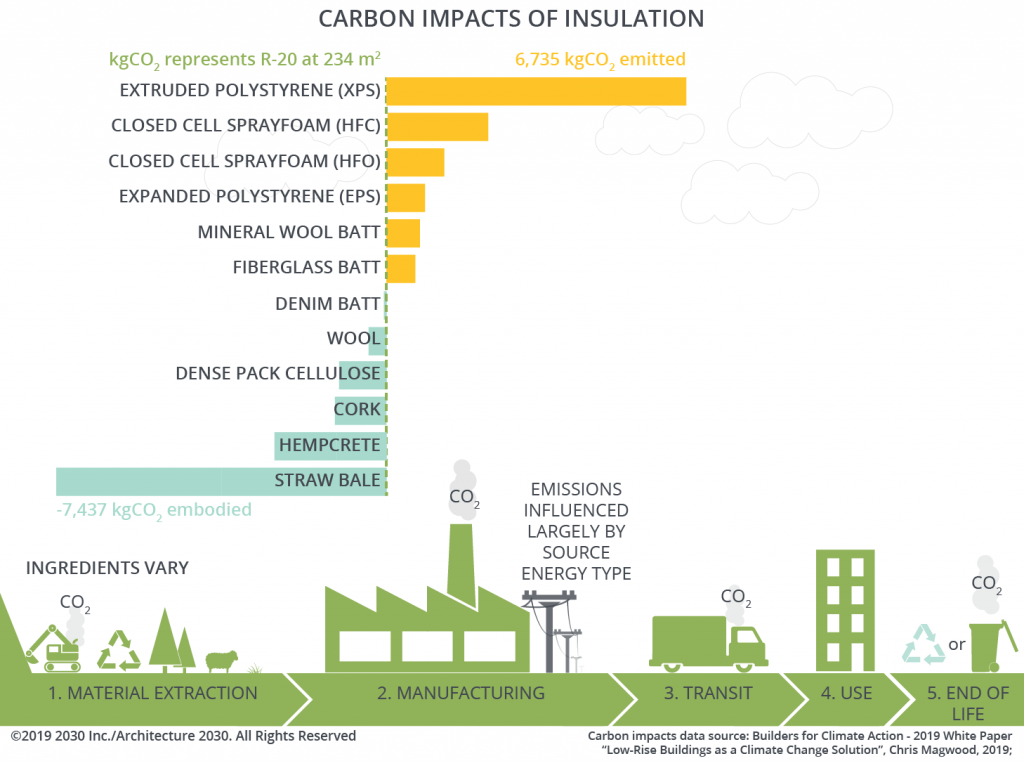
Source: Carbon Smart Materials Pallette
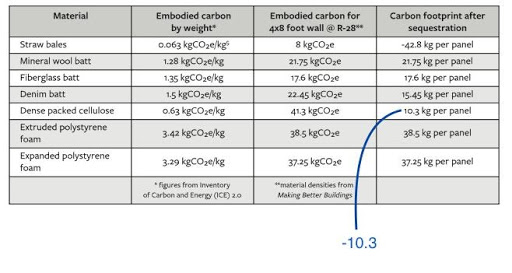
Building Science published this chart showing the carbon footprint of a variety of loose packed or batt insulation materials.
The chart shows the embodied carbon of a number of common insulation materials, compared equally at a value of R-28. The materials range from a low figure of 8 kilograms of CO2e (total emissions expressed as a volume of carbon dioxide) for straw bales to a high of 38.5 kilograms for extruded polystyrene (XPS) for a 4×8 foot wall section. Compared by embodied carbon, straw bales have a fraction of the impact of other insulation materials. On this basis, it is a great choice, but labor costs are high. Considering the amount of carbon sequestered in the straw, the comparison becomes particularly noteworthy. (Hempwool batts are also available that may sequester carbon as well.)
An R-28 straw bale wall may sequester 42.8 kilograms of CO2, not only compensating for the small amount of embodied carbon but giving it a negative GWP. The cellulose in straw is 37% to 51% carbon by weight. As long as the straw does not decay or burn, that carbon will stay trapped for decades or centuries. While straw bales are difficult to see as a mainstream building material, using straw-based material and other bio-based materials for cavity insulation or for building envelope panels, such as structural insulated panels (SIPs), holds much promise.
Low and negative GWP SIPs and panels
There are many companies now making low-GWP structural insulated panels (SIPs) and customizable panels from straw, wood chips, wool, and/or hemp. Some claim, perhaps correctly, that their products sequester carbon. Bensonwood in New England, a leader in the field, uses dense-pack cellulose. Tooke Tree in Ontario uses dense-pack cellulose, wool, and/or wood fiber. Simple Life, also in Ontario, uses cellulose and straw bales. EcoCocon, a European company with products now available in the U.S., uses straw insulation in wood framed panels. B.Public Prefab in British Columbia uses dense-packed cellulose. And the Alpha System from Germany, manufactured in Colorado, uses cellulose, and will soon be available. Some of these companies ship their panels throughout North America.
Cellulose and straw-based insulation materials may well have carbon sequestering potential depending on their having been raised, processed, and transported sustainably. These claims are well worth checking out. Many of these manufacturers ship long distances, so it would be worth giving them a call to check out their shipping rates to your location. Of course, the carbon emitted in shipping should be included in your carbon accounting—so local is better.
For builders and designers interested in getting to zero carbon, it may be time to explore what options are available for lower GWP insulation materials that may be cost comparable to current materials. While the perfect, most cost-effective solution, may not yet be at hand in your area, it is well worth examining the options mentioned here. Each year will bring more cost-effective low GWP insulation options.
Joe Emerson is a co-founder of the Zero Energy Project, where this article first appeared. It is republished here with permission. All illustrations courtesy of the author.
Weekly Newsletter
Get building science and energy efficiency advice, plus special offers, in your inbox.





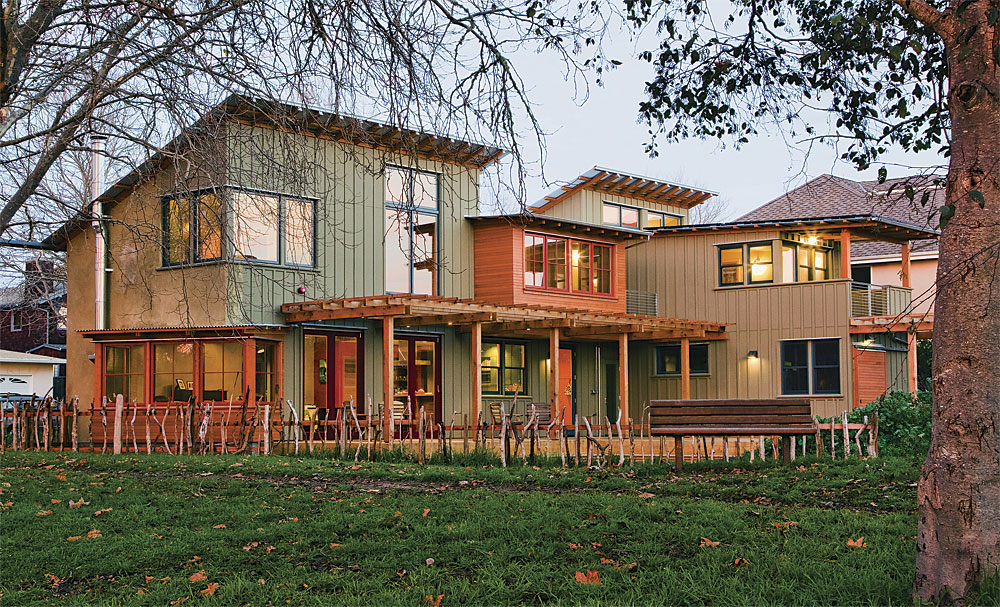
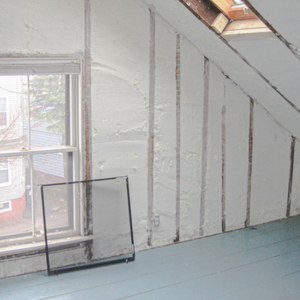
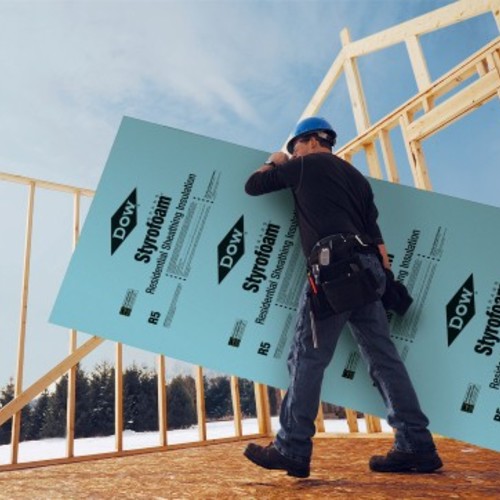
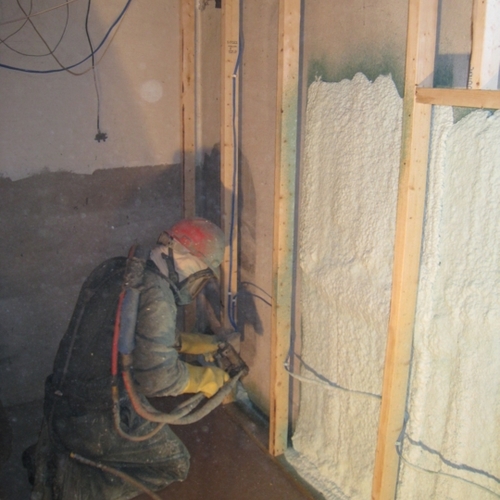






12 Comments
Mike has written about this in the past, too. An important discussion. https://www.finehomebuilding.com/2018/11/07/h280-is-using-closed-cell-foam-worth-the-trade-offs
Have recently learned that HFO blown foam is the ONLY type of foam that is legal here in California, but that does not mean that companies are necessarily installing HFO blown foam. I had to search a bit to find a company who knew what it was and was told they could get it if it's spec'd. It's out there though, so at least an option.
What's up with that second chart showing XPS and EPS as nearly identical? Maybe that is European HFC free XPS? I followed the link but it was the same chart with no sources or details. This should be removed from the article--regardless of how it came about it's wrong for North America.
It's hard to understand why so many people don't care about the AGW potential of some spray foams and foam boards. You certainly can't make people care even though it will affect the environment on this planet. It is exactly the same (in this country) of telling people that they should wear masks to control the Covid-19 pandemic. You only need one idiot at the top to say that he doesn't want his freedom restricted for everyone of a certain temperament to fall in lockstep.
Of course the current president is also the one who replaced all the top officials in the EPA with ones that reversed the proposed tighter restrictions on XPS foam. But it's important to keep XPS unrestricted because otherwise one would be virtue signaling. We wouldn't want to do that. It's far better for multitudes to die unnecessarily than to restrict our individual freedoms by banning high global warming potential foams (or to enforce mask wearing.) If we would restrict those freedoms in any way it would mean we are looking down on others and thinking we are better than other people.
I guess since I mentioned mask wearing it might mean we can make some sort of correlation with the current administration's stance on foam insulation regulations. It's important to remember that our president said we have the lowest rate of Covid infection, the lowest mortality rate and that we are generally in great shape with regard to the pandemic. If his record record of success with that is also relevant to his regulations on the environment then I think we should be afraid, very afraid, for our future.
Search Dunbar's Number for some insights.
Great information in this article!
I just want to clarify the difference between mineral wool batts and mineral wool rigid panels that would be used as exterior continuous insulation and the comparison of that to EPS. I want to use mineral wool for many of its attributes in my design, but a product like Roxul ComfortBoard 80 or RockBoard 80 has a density and weight of about 4 times that of ComfortBatt. In the charts I see that Mineral Wool Batt has slightly less embodied energy than EPS insulation but fairly close to the same. Thus I expect that rigid mineral wool board has embodied energy that is a good deal higher than mineral wool batts and EPS insulation. . . correct?
I believe the following BuildingGreen article also supports this conclusion. https://www.buildinggreen.com/news-article/avoiding-global-warming-impact-insulation
It shows EPS as having a lower lifetime GWP per R value than mineral wool.
I appreciate any feedback, as we endeavor to use the best design, that is evidence based.
-Marc
Very nice article. With Cellulose, I am wondering what the current day source for the raw material is, with less and less News papers being printed.
I have been wondering the same thing....
I am wondering where dense-pack Cellulose would stand if we include the GWP of paper-production (post consumer waste paper), borate, etc. I am wondering about this since in a totally digital economy, we won't have any paper/news-print available for dense-pack cellulose, right?
Here is an old discussion by Robert Riversong in 2011. I think the trend is in the direction of less print media but I think the suggestion of it's imminent demise might be exaggerated, even now.
"The US waste stream is 30% paper by volume and 35% paper by weight. As much as 14.4% of landfill volume is newspaper - the largest single contributor by either weight or volume. Only about 25% of all paper is recycled in the US. Newspaper in landfills produces methane gas, 20 times more powerful than CO2 in producing global warming."
Thanks. Does cardboard, the kind used in Amazon packaging, end up in cellulose insulation as well?
It does, though I don't know what percentage. At least one manufacturer is focusing on cardboard packaging as its primary source of stock, apparently specifically in response to dwindling newspaper volume: https://www.cleanfiber.com/about
Is anyone familiar with Gaco OnePass Low GWP F1880?
Log in or create an account to post a comment.
Sign up Log in